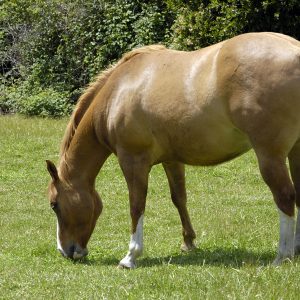
Insulin dysregulation in horses explained so you can understand it.
The most common question I get is, “What exactly is insulin resistance or dysregulation?”
The following is not a scientist’s explanation. The process of glucose and insulin regulation is a complex biochemical dance that includes a host of various participants and steps, but this explanation should help clarify things for the typical horse owner.
First let’s review what happens in a normal horse in very basic terms.
When a horse eats a meal or is out grazing, the feedstuffs he eats are digested (broken down into smaller nutrients) and absorbed into the bloodstream. Glucose is included in these nutrients.
As the blood circulates through the body it is monitored by various organs (kidney, liver, pancreas, etc.) and depending on the blood’s composition, these organs react accordingly. In the case of glucose, when the levels increase in the blood, it stimulates the pancreas to release a hormone knows as insulin.
Hormones are the body’s messengers; they essentially run the show. Hormones communicate all manner of directions to various parts of the body. In this case, the hormone insulin enters the bloodstream and heads out to tell the cells throughout the body that there is glucose available in the bloodstream and that they should absorb that glucose through their cell membranes. Think of the cell membrane as a window that the cell can open and close. The window is closed to keep out unwanted invaders and opened to allow beneficial components to be absorbed. Cells that absorb glucose use it for energy to fuel whatever function that particular cell performs.
As the glucose is absorbed by the cells, the levels in the bloodstream drop. The pancreas notes this decrease and stops sending out the insulin messengers. Blood parameters return to basal levels and all is well. In a horse with insulin dysregulation, there is a breakdown in the process. The body digests and absorbs the nutrients into the bloodstream, the pancreas identifies the increases levels of glucose in the blood and sends out the insulin messengers, but the cells just ignore the insulin. They become “resistant” to the signal to absorb the glucose out of the bloodstream. They don’t open the window and let the glucose in. This causes the glucose in the bloodstream to keep increasing. In response the horse’s pancreas sends out more and more insulin until the entire process spirals out of control.
As a result of the dysregulation, cells don’t get the energy they need to function properly, and the high levels of circulating glucose and insulin have a negative impact on multiple systems within the body. It can lead to abnormal fat deposit, obesity and the dreaded laminitis.
At this time, we don’t have a cure for insulin dysregulation (ID). It is a degenerative disease that gets worse over time. Instead of curing ID we manage the level of glucose the horse is exposed to by feeding a low-sugar diet. A horse still needs some glucose to survive, and the key is to provide just enough. This tactic helps to keep blood insulin levels low.
We also carefully monitor the horse’s weight to guard against obesity, which seems to exacerbate the problem. We exercise the horse, which naturally increases the cells’ ability to recognize and react to the messages insulin is delivering. And veterinarians administer medications and recommend supplements that hopefully decrease the insensitivity that has caused all this havoc to being with.
Managing a horse with insulin dysregulation is truly a human attempt to control a balancing act that has gone awry!


